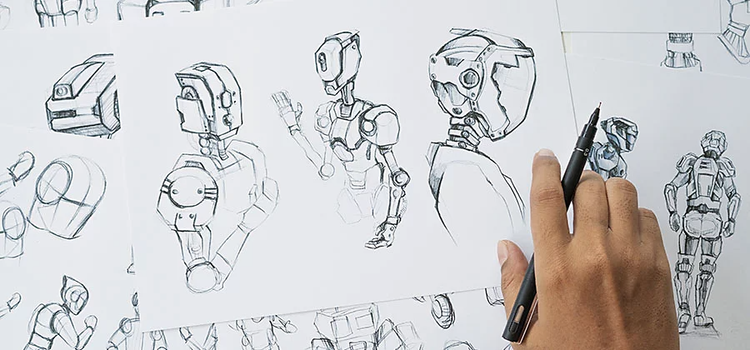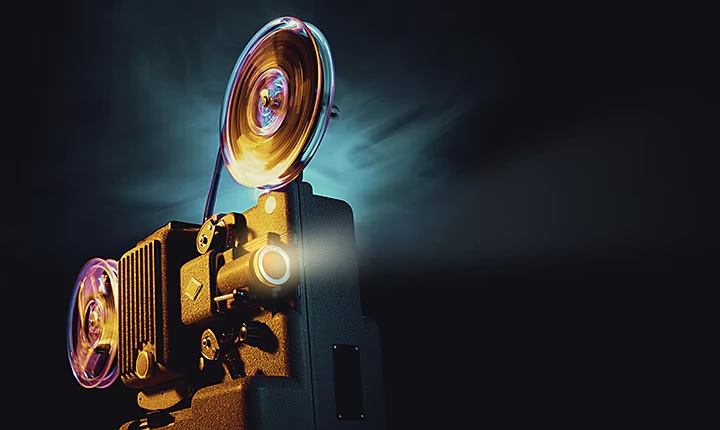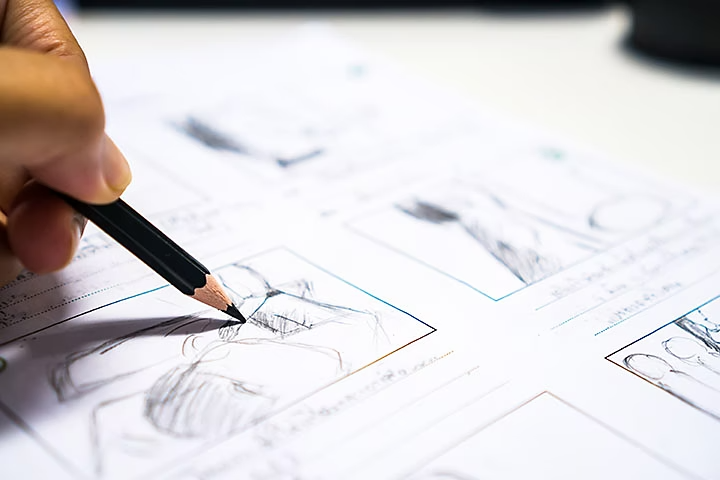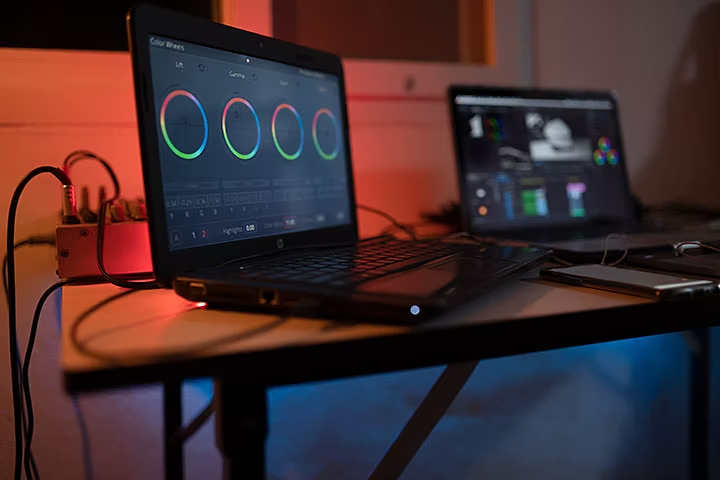Animation FEATURES
A beginner’s guide to animation: types, techniques and tutorials.
From Snow White to South Park, Monsters, Inc. to Minecraft, animation captures the imagination like little else. Most of us have a favourite animated film that we’ll carry with us forever. Gaming has long ago crossed into mainstream culture. Sitcoms like The Simpsons are just as acclaimed as their live-action counterparts.

But there’s more to animation than entertainment. Today, you’re just as likely to find animators in marketing teams as Hollywood studios. During the Covid-19 pandemic, you could see CGI virus animations on the news every day. According to Bloomberg, the global animation market is set to reach $640 billion by 2030.
So what it’s like to be an animator? How’s animation changed? And perhaps most importantly, what is animation?
In this article, we’re making like Ariel and taking a deep dive.
What is animation?
In short, animation means filming a rapid succession of closely related static images to create an impression of movement.
It’s based around an optical illusion called ‘persistence of vision’. Our eyes only retain images for one tenth of a second, so when we see them appear quicker than that, our brain merges them together.
To create this effect, most animations capture 12-24 individual images per single second of film. Before CGI techniques came into prevalence, these images were often hand-painted or drawn onto celluloid (cel) sheets.
This was painstaking work — and high-budget productions hired enormous animation teams to do it. 1994’s The Lion King, for example, employed 600 animators and technicians.
Today, animators are more likely to use CGI techniques, which removes some of the labour from the process, but is nonetheless a highly specialist technique.

Is animation the same as cartoons?
Cartoons are animated films, often dealing in exaggerated visual style and wacky plotlines. They’re made using animation techniques but have a distinct history to other animation styles. They can be traced back to the satirical magazine/newspaper illustrations and comic strips of the 18th and 19th centuries.
Is animation the same as animatics?
Animatics are rough sequences of images used to help animators and directors plan shots, timings and scenes. They’re essentially an animated storyboard, commonly used in anything from cartoons to commercials.
To make an animatic, animators traditionally filmed individual drawings with a camera. Today are more likely to use programmes like Adobe Illustrator or After Effects.
Is animation the same as anime?
Anime is a style of Japanese animation. It’s a highly diverse medium, but is often characterised by its imaginative plotlines, distinctive camera work and beautiful settings. You can see classic anime style in series like Pokémon or Studio Ghibli films like Spirited Away.
What are the types of animation?
Stop motion animation.
To create stop-motion animation, animators physically manipulate objects in tiny increments to create the impression of movement. Examples of this low-budget but highly distinctive style include Tim Burton’s A Nightmare Before Christmas or the early cutout motion work of Matte Stone and Trey Parker.
2D animation.
You can see moving 2D figures in zoetrope machines — one of the earliest animation devices. Zoetrope machines wowed Victorian audiences with a set of sequenced images within a rotating, slatted cylinder. Today, 2D animation is commonly associated with moving vector images created using Adobe Animate (formally Adobe Flash). Flash animation was a mainstay of mid 2000s online cartoons and games.

CGI animation.
You’ll find CGI animation anywhere from your favourite videogames to the latest Pixar smash hit. Like 2D vector animation, CGI artists ‘rig’ their characters with a set of key movements in a technique closer to puppetry than traditional animation.
Motion graphics.
Motion graphics bring text, logos and other static designs to life. You’ll find motion graphics in TV ads, explainer videos and animated logos.

Other animation techniques.
- Claymation. Claymation artists use stop-motion techniques to capture the movements of miniature clay models. The result is charmingly lo-fi but highly intricate. Famous claymation artists include Wallace and Gromit creator Nick Park.
- Flip book animation. If you want to see the essence of animation, take a look at a flip book. These booklets contain a series of images that, when flicked between pages, gradually create the impression of a moving image.
- Morphing. Beloved of sci-fi, horror and fantasy creators, morphing involves transitioning one image into another. Morphing had something of a heyday in 1980s and 1990s music videos and live action films.
- Walk Cycle. A walk cycle ties a series of individual motions together to create the impression of walking. This cycle is then repeated to avoid having to animate each step again. Creating a basic walk cycle of four key motions is relatively simple, but making realistic walk cycles requires close attention to detail.
- Animation lip syncing. Animating a mouth to match its speech can be complicated — but it’s essential to creating a realistic character. Today, AI technology does a lot of the heavy lifting.
- Cel Shading. Cel shading is used to make 3D computer graphics appear flat. This can be used to mimic comic book or cel animation aesthetics.
- Rotoscoping. In this technique, animators trace animated images over motion picture footage, traditionally using a glass-panelled device called a Rotoscope. Today, the process has gone digital — but the name has stuck.
- Easing (CSS). Easing help animators create realistic transitions in movement. It’s a subtle but important art — when we throw a ball or open a drawer, it rarely opens at the same speed. Easing makes these everyday actions feel more natural.
- Rigging. This technique is widely used in 3D and 2D animation to create moving characters. Animators create a rig or skeleton, consisting of a surface representation and a set of interconnected parts, with a set of key movements.
- Masking. You can use masking to cover and hide portions of an image against a backdrop — creating the illusion of an object moving in and out of its setting.
- Mechanical animation. Engineers often create 3D renderings of complex mechanical goods. This helps them to demonstrate the way their products work — from assembly to repair.
- Typography. Typography animators animate text for film, TV and marketing. The field can also cover font design.
History of animation.

In the 17th century, magic lantern projectors presented audiences with moving figures on static backdrops. Two centuries later, Zoetrope and phenakistiscope devices created a series of quickly changing images to suggest movement for perhaps the first time.
By the early 20th century, filmmakers were taking advantage of camera technology to create animations from hand drawings and stop motion techniques. Emile Cohl’s 1908 Fantasmagorie is one of the best-known works of the era. Six years later, Earl Hurd created cel animation — the dominant animation technique for the next seven decades.
Walt Disney’s Steamboat Willie, the first outing for Mickey Mouse, was released in 1928. This was the start of a golden age of animation. The 1930s saw the launch of Disney characters from Goofy to Donald Duck, as well as Warner Bros’ Looney Tunes creations like Bugs Bunny. Within the next three decades, Disney released motion picture classics from Snow White and the Seven Dwarves to The Jungle Book. In the 1960s and 70s, countercultural animators, puppeteers and stop-motion artists brought non-mainstream techniques to a mass audience. Terry Gilliam’s anarchic sequences in Monty Python’s Flying Circus blurred the line between cutout and collage. Elsewhere in the UK, Oliver Postgate’s stop-motion creations like The Clangers charmed viewers with a gentle world of mouse-like creatures who lived on the moon, spoke in whistles and ate only soup.
Cel animation would remain prominent way into the 1980s. Here, we see the Studio Ghibli films like My Neighbour Totoro making inroads with Western audiences. But by the end of the decade, advances in computer technology led Disney to adopt digital techniques in productions like The Rescuers Down Under.
Meanwhile, Pixar’s CGI short films like Luxo Jr. were gaining traction in tandem with the rise of 3D videogaming in Japan. Pixar’s first feature film, 1995’s Toy Story, was released to critical and commercial acclaim. The CGI era had begun.
How do I get started as an animator?

Animation software.
Whether you’re a budding CGI artist or an OG claymation purist, you’ll need solid software to get started.
- Adobe Animate. Your go-to choice for web, TV and gaming creations in 2D and 3D. It’s easy to get started with a quick doodle and before you know it your design with be a blinking, breathing, talking masterpiece. Here you can pick up all the tricks of the trade — from tweening and rigging, through to sequencing.
- Adobe After Effects. Ready to step it up a notch? After Effects helps you to take your creations even further with visual effects, motion graphics and compositing. Here you can create your animation pop from opening credits to post-production.
- Adobe {{premiere}}. Are you a stop-motion artist? {{premiere}} is the place import your images and piece them together. Sequence, edit and animate all in one place.
Animation tutorials.
Ready to make a start on some animation tasks? We’ve got a range of great resources from our global creative community to help.
- Turn a sketch into an animation. Create a vector shape on your iPhone, iPad or Android device and bring it to life as an animation or animatic.
- Draw with brush tool. Use Brush to draw artistic, engaging characters and objects. Experiment with pre-sets, paint and techniques like onion skinning.
- Use the actions wizard. Add interactivity to your visuals with no need to learn code. Use sample files to learn the ropes before applying your techniques to your own design.
Animation career.

Animation is a dream job for many of us. But how do you get started? These simple steps can put you on the right path towards landing an in-house role, going freelance or just learning the skills you need to create for fun.
- Dedicate time to your craft. You might have a natural flair with animation, but you’ll need to take time to hone your skills. Remember to read around your topic - particularly theories like the 12 principles of animation. Get inspired by well-known and more obscure animators and delve into subjects outside the direct field. Understanding acting, for example, can help you to create a more fluid, realistic character.
- Take courses. Very few animators are likely to be completely self-taught. In fact, the US Bureau of Labour Statistics say that most animator positions require a bachelor’s degree. Whether or not you choose to go down the college route, some form of education is essential to learning the techniques and software skills you need to animate.
- Start creating. Equipped with software, new skills and inspiration from teachers, experts and peers, it’s time to start creating. Use Adobe Animate to start creating characters, sequences and short films.
- Make a portfolio. A killer portfolio is essential to proving your skills as an animator. This is a chance to demonstrate how you’re unique - and how you can bring stories, characters and objects to life better than the competition. Don’t forget to get inspiration from other creative portfolios online to help yours stand out. Adobe Express is a great place to get inspiration and easily drag your files into a template.
- Get experience. Armed with a portfolio, it’s time to get your name out there. You can try approaching animation and design studios or even keeping in touch to individual animators for assistant work.
- Apply. If you’ve got qualifications, experience and a portfolio, you should be in a pretty good position to land an in-house role or go freelance. Create fun, creative applications and be patient. Creative jobs are competitive - but with the right attitude and skills, you’ll get there.
Animation process.

Whether you’re a studio animator, a creative freelancer or just a hobbyist, you’ll find the process of creating an animation follows a similar pattern. Let’s check it out.
- Story. Every animation should tell a story — whether your film lasts for ten seconds or two hours. Remember to develop a story — no matter how simple — before you start production. This will make your workflow more efficient and give you a clear concept. What’s more, it will make your animation more engaging.
- Script and concept art. Next, it’s time to put your story to the page (or screen). A script can help you spot any issues with your story. Concept art helps you to establish a consistent visual style.
- Storyboard and animatics. Storyboarding is essential to planning the pace, beats and look of your film. Once you’ve created a storyboard, take it further with an animatic. This is a great way to get a very rough early impression of how your story will look.
- Animate. Now to bring your character to life. Start with a reference video to nail down the specific movements your figure will follow. Next, create key frames in your design software to represent the essentials of the movement. Creating in-between motions (and splining them with your software) will help to make these movements more fluid. Then add life, details and imperfections to make your character realistic. Take note of the 12 core principles of animation to make your creation feel real and full of personality.
- Post-production. This is phase is essential to animation development. Time now the special effects and lighting wizardry your film needs to make it pop from the screen. You’ll also need to render your designs to capture the data and stills from your film. Colour correction and grading is also essential to make each shot match the last.
- Music. Finally, it’s time for your soundtrack. Add music, sound effects and dialogue to complement your animation.
Animation 101: what do the basic terms mean?
- 2D animation. The two-dimensional style followed prior to the CGI era. Think zoetrope machines, cel animations and vector art.
- 3D animation. Animations created with polygons on computer software. Pixar films are a great example. You could also stop-motion as 3D.
- Stop motion animation. Using clay figures, puppets or any object they choose, stop-motion animators film incremental movements in this painstaking but beloved genre.
- Frame rate. The speed in which images are shown, usually expressed per second. Animators normally go for 12-24 frames per second.
- Key frame/pose. The start and end-point of a movement within a frame. In 3D animation, these are created as part of a character’s skeleton or ‘rig’.
- Inbetweens. The incremental motions between two key frames that create a smooth transition. These are sometimes interpolated using software.
- Thumbnails. These are used to sketch out rough ideas for a scene or character or to be used as placeholder in a final image. Animators often used to get sign off or feedback from seniors or creators.
- Timing. Every action is planned to the finest detail in animation. Timing refers to how long a movement will take from start to finish.
- Spacing. Spaces between frames designed to create consistent movement. Essential to realism.
- Easing. Like spacing, easing is all about making movements feel real. In this case, easing is about the speed and pacing of a movement.
- Compositing. Placing the disparate elements of a scene into a cohesive whole.
- Storyboard. Planning how each shot will look before production. When animated, a storyboard is called an animatic.
- Inkblot. This simple animation style helped early cartoonists produce at pace. It’s also known as Rubber Hose animation, because many characters looked as though wearing rubber tubing. See Mickey Mouse in Steamboat Willie.
- Colour script. A working document used to establish colour combinations and how they relate to emotional themes and touchpoints in a story.
- Colour grading. Ensuring colour consistency from shot to shot.
- Twinning. When two parts of a character, usually on opposite sides of the body, move the same way. This is seen as unnatural.
- Tweening. The images that go between keyframes to make movement look fluid and natural.
- Animatic. An animated storyboard used to plan shots and get a feel for the finished piece before production begins.
- Overlay. Text and images overlayed onto an animation to add details. These could include titles, captions or watermarks.

Discover more about animation.
- Stop Motion Animation Explained
- Animation Key Poses
- What Is CGI Animation?
- 12 Principles of Animation
https://main--cc--adobecom.aem.page/cc-shared/fragments/seo-articles/get-started-notification-blade